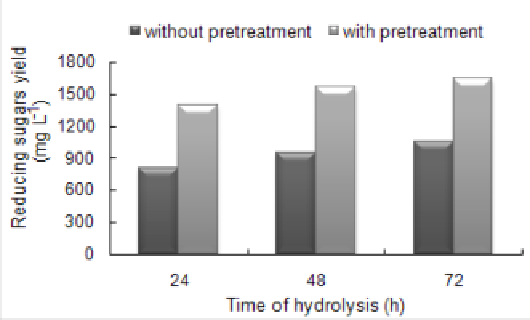Agriculture Reference
In-Depth Information
cerevisiae
can not naturally ferment galacturonic neither acid nor pentose sugars but has a
homoethanol pathway.
Erwinia chrysanthemi
is capable of degrading many of the cell wall
components of pectin-rich materials, including pectin.
Klebsiella oxytoca
can metabolize a
diverse array of sugars including cellobiose, one degradation product of cellulose. However,
both
E. chrysanthemi
and
K. oxytoca
produce side products during fermentation, similar to
E.
coli
[48].
When cultivating
Saccharomyces cerevisiae
which is the most commonly used
microorganism for bioethanol production, one more important characteristic should be taken
into consideration - its high sensitivity to hemicellulose and lignin degrading products that
can be formed during the pretreatment (e.g., in strong acidic environment at high
temperatures) [49]
.
S. cerevisiae
is unable to produce native enzymes to hydrolyse cellulose,
hemicellulose and pectin, so enzyme saccharification by exogenous enzymes is neccessary for
the hydrolysis of sugar beet shreds. Complete enzymatic hydrolysis of only one component of
beet shreds, cellulose, to glucose requires several classes of enzymes and might represents
hurdle for commercialization of cellulose to ethanol processes as it was found for other
lignocellulosic substrates [50].
Another challenge specific for sugar beet shreds as source for bioethanol production is
high pectin content. Namely, pectic substances associate with cellulose [51]
which might
effect yield of enzymatic hydrolysis of cellulose by hindering exposure of it surface to the
enzyme action. In order to overcome this disadvantage, enzymatic hydrolysis of sugar beet
shreds previously subjected to acidic pretreatment was investigated from the aspect of
S.
cerevisiae
as fermentative microorganism. Conditions for pectic substances extraction by acid
were mild in order to prevent formation of degradation products that can be toxic to the
fermentative microorganism. In addition, although polyethylene glycols (PEG) were reported
to have a positive effect on results of hydrolysis of different lignocellulose materials due its
interaction with lignin [44], almost no information has been reported on their effect on sugar
beet shreds hydrolysis. Hence, the objective of this work was to investigate releasing of
reducing sugars during enzymatic hydrolysis of cellulose in the sugar beet shreds, in respect
to enzyme concentration, substrate solids load and presence of PEG [52].
Figure 2. The effect of acidic pretreatment on yield of enzymatic hydrolysis of sugar beet shreds;
enzyme concentration 10 FPU/g, solids load 2.5% (w/w), temperature 40
o
C [52].


